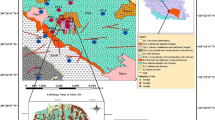Abstract
The focus of this research was to determine the impact of abandoned mines on surface water and groundwater in the historical mining districts of the Cerbat Mountains, Arizona. The surface water in the mining areas was found to be contaminated by various combinations and concentrations of heavy metals. Elevated arsenic, cadmium, and iron concentrations were detected in most surface-water samples, while lead, copper, and zinc contamination differed from region to region, depending on the ore mined. The groundwater was seriously polluted by arsenic, cadmium, lead, zinc, iron, and manganese in the immediate vicinity of mines that processed ore on the site, such as the Tennessee Mine near Chloride. Chloride's groundwater, however, showed no evidence of contamination. Three possible explanations are discussed: immobilization of the heavy metals in the soil by chemical reactions and adsorption, dilution effects due to the rainy season in spring, or the existence of different groundwater systems.
Similar content being viewed by others
Author information
Authors and Affiliations
Additional information
Received: 17 September 1996 · Accepted: 14 May 1997
Rights and permissions
About this article
Cite this article
Rösner, U. Effects of historical mining activities on surface water and groundwater - an example from northwest Arizona. Environmental Geology 33, 224–230 (1998). https://doi.org/10.1007/s002540050241
Issue Date:
DOI: https://doi.org/10.1007/s002540050241




